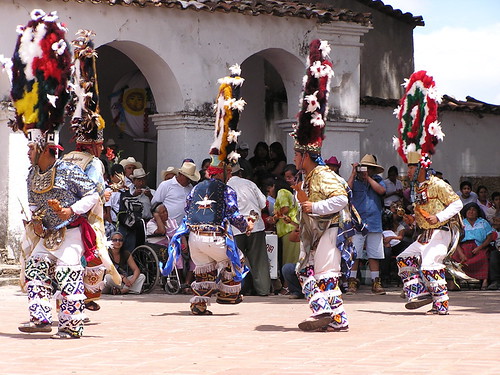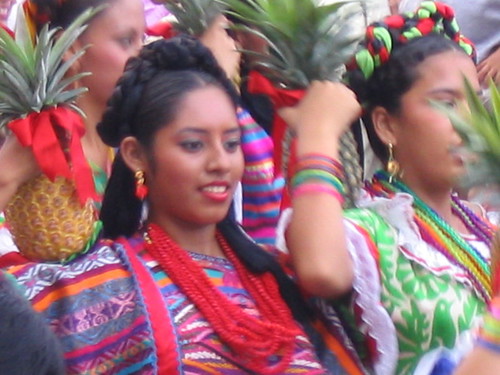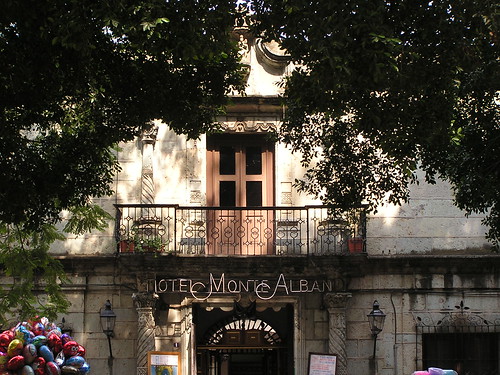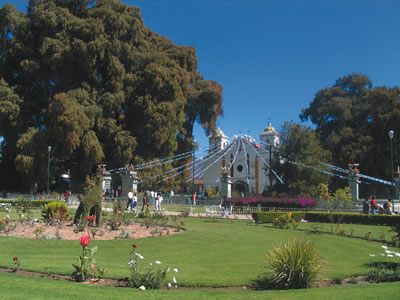Latin American Travel Planner
Article and Photos by Ron Mader
Responsible Travel
Contributing Editor

|
|
Dancers perform the Danza de la Pluma in Teotitlan del Valle, a 10-hour marathon re-enactment of the meetings and battles between the Spanish and the Aztecs. Visitors are cordially invited to watch the performance in front of the town's church every July during the festival.
|
Much of Latin America is easy to visit.
Want to make the most of your budget? Slow down! The chief expense is transportation, so if you slow down, you can go further. One of our mottos on Planeta.com is to think smart and travel slow. Instead of covering vast territorial expanses in a limited period, we suggest being a slow immersion traveler who takes the time to experience the places you visit more fully.
Latin America is enjoying renewed interest due to its cultural and environmental diversity. Environmentalists talk of biodiversity — the species-rich forests of Mexico and Brazil, the abundant birdlife in Costa Rica and Honduras, and the megadiversity found in Brazil, Colombia, Ecuador, and Venezuela.
Whether your idea of a good time is hiking the Andes, buying crafts in Oaxaca, snorkeling along the Maya Reef, volunteering in rural communities, or learning how to cook a tasty tamale, travel options abound. Most are a bargain if you know where to look.

|
|
In Oaxaca City, Mexico, the Guelaguetza is one of Mexico's premiere celebrations
of dance and music. It was practiced before the arrival of the Spanish and
continues to grow. Celebrations are held in Oaxaca City and nearby towns.
This is the largest folklore festival in the Americas.
|
The Fundamentals of Trip Planning in Latin America
Planning your trip begins with the magic words you utter to yourself: "I could take a trip." It continues until the moment you arrive at your destination. Planning your journey should be half the fun.
First, you must decide whether to make up your own itinerary and go as an independent traveler or prefer purchasing a packaged trip.
Crafting your itinerary does not mean you have to stick to a day-to-day agenda, but rather that you can make the most of your individual preferences and lucky coincidences. Often, this works out best if you allow for an extended period to enjoy your trip so that if you find a town enchanting, you can spend more time than you had initially planned. Likewise, if you meet with interesting travel mates, you can be flexible when you allow spontaneity.
Though sometimes sacrificing flexibility, packaged trips provide more comfort — if only for the knowledge that meals and lodging will be taken care of for you. Other reasons to opt for a pre-planned trip include the reassurance that group tours put travelers in charge of a professional guide. Many specialty travel organizations with tours in Latin America take pride in their knowledge of niche categories — rafting, mountain climbing, archeology, gastronomy, etc.
Where to Find Information on Latin America
Find out about as much as you can before taking off for your trip to any country in Latin America. Getting detailed information about countries in the region is no trouble these days — whether via the web, guidebooks, or by calling government tourist offices. Research your destination's weather patterns. Find out if there are special events that you can attend. Investigate the seasonal migrations of animals. Timing is often everything. For example, from late December to early March, Mexico is home to the famous Grey Whales and Monarch butterflies. Just don't come a month too early or too late!
The quality of guidebooks varies as many publishers are choosing to refrain from renewing contracts with veteran writers. In my opinion, the result is a decline in quality; many newbie writers do not have the same connection to the place they cover. Nevertheless, I still find myself using good guidebooks. I have yet to pick up a book from which I didn't learn something — which is an excellent way to measure the value of information. I always travel with two or three books, or access them as eBooks, and compare how the different authors cover a particular region.
The prime disadvantage of paper guidebooks is the time required to produce them; when the information is in your hands, you'll have to return to the web for an update! The advent of the eBook makes it easier for the books to be updated more frequently. Updates are necessary in Latin America, since phone numbers and addresses change more frequently than the publisher's revision schedule, which means access to the web is always nice to have.
In have often found that the best source of travel information in Latin America comes from other travelers you meet on the road. Ask others what they have seen and enjoyed. Word of mouth is almost always the preferred form of information about a region.
Passports and Visas
Make sure you get all the details about visa requirements ahead of time. Given recent U.S. policy changes, many countries, including Brazil, are adding bureaucratic hurdles for those entering the country.
If you are flying, the airline will let you know if they provide the necessary tourist card or visa or whether you need to contact the country's consulate or embassy. Check visa requirements around the world in TransitionsAbroad.com's section on Embassies
and Visas.
Your Personal Budget for Latin America
The primary expense involved in a trip to Latin America is transportation, particularly if you are not crossing overland. If you have the time, consider the transportation investment and make the most of your visit by staying at inexpensive hotels or homestays frequently arranged by the many Spanish language schools.
As you plan your trip, determine your spending limit. I have never adhered to a strict daily budget, but I have always had a clear idea of what I could and couldn't spend.
In-country prices will always fluctuate when a country experiences drastic inflation or a devaluation of its currency, and sites like Numbeo.com can provide the crowdsourced information that should offer you a general idea about a country or city you are about to visit. But prices fluctuations have happened frequently historically in Latin American countries, usually to the detriment of the local population. Whenever possible, be a responsible guest. If currency devaluation occurs, we find it respectful to avoid overly gloating at your new fortune and be sympathetic to the natives, your hosts, who often do not share in the benefit.
(Editor's note: See Tim Leffel's articles on Budget Travel in Mexico in Central America amd Budget Travel in South America for tips.)
Healthcare in Latin America
Any time you travel away from home, your body is in for a shock, so be kind to it. Germs are easy to catch, so listen to your parents' distant voice and wash your hands before meals. If you don't trust the water, use an anti-bacterial waterless soap.
"Stomach upset" is commonly known throughout Latin America as turista. While major cities often have modern water treatment plants, leaky pipes may contaminate the water.
Bottled water is generally safe; so is water that's been boiled for 20 minutes. Make sure that the food you eat has been well cooked. If you want salad, lettuce, or tomato, make sure they have been washed in purified water. If you're traveling into remote areas, you can take water purification tablets with you. Avoid water unless it is bottled or purified. Coffee and tea are generally fine, and you won't get sick from pop (refrescos) or beer (cerveza) — unless you drink too much. Moderation is suggested, but that's advice better preached than practiced.
Another common complaint concerns air pollution, particularly in Mexico City, but also common in Guadalajara and Monterrey, Mexico, not to mention Guatemala City and Santiago, Chile. The most affected are children and older people. I wish there were a pill to take. Meanwhile, your best bet is to take it slow and easy.
If you do need medicine, pharmacies are generally well-stocked. Prescription drugs are also easy to get. If you are taking a particular medication, bring a copy of your prescription as a safety precaution.
Specific immunizations are rarely required for travel to major cities or tourist resorts. However, getting tetanus, typhoid, and polio shots makes sense if you're traveling in rural areas. Consult your family doctor and the U.S. Center for Disease Control.
Safety in Latin America
Anyone who has traveled in a developing country is familiar with safety concerns. Travelers are often seen as possessing great wealth, regardless of whether that is true.
Do not be ostentatious. A developing country is not the locale to display an expensive watch or briefcase. When in public, avoid wearing jewelry or talking loudly.
Beware of crowded situations. The Mexico City metro, for example, moves five million people a day and has been the location of numerous robberies. If it's too crowded, don't get on.
Keep your luggage in sight at all times.
Please make a copy of your passport and/or visa and keep it in a separate location or have access to a paper copy or via a secure cloud. If you are robbed of documentation, copies make replacement much more straightforward.
If you are ever attacked, which is not as common as much media will make you believe, just don't resist, as in any place in the world. In two taxi cab incidents that took place last year in Mexico, one journalist was paralyzed and another murdered after they attempted to fight against their attackers.
(Editor's note: See Volker Poelzl's articles on Travel Safety in Central America and Travel Safety in South America for more tips.)
Transportation in Latin America
Unless you are planning on going the ground route, most travelers to Latin America arrive via airplane. Check current prices without committing yourself or taking too much time with a travel agent. Many newspapers offer a list of the best prices. It is also easy to check on fares from many airfare websites. Get an approximate figure and then visit your favorite travel agent. I am old-fashioned in this regard, but I would rather deal with a human being than a mere website. Super deals are rare or impose too many obligations, including when you leave and/or return.
Once you have arrived in Latin America, you'll notice that bus transportation is the most popular form of public transportation and is generally quite good. First-class buses provide comfort to long-legged travelers. Second-class buses are cheaper and traverse rural areas. If you are short on time, you can always rent a taxi by the day; it often costs less than renting a car. Trains have played historical roles in the region's development. Regardless, as a mode of transportation, the quality is on the decline. Many countries offer flights but at varying prices. A twenty-minute hop across the Sea of Cortez can start in economy ferries at more than $250, while in-country flights in Ecuador often cost less than $100.
(Editor's note: See Tim Leffel's article on Getting Around in Mexico for more tips. See also Volker Poelzl's series of articles on Air, Land, and Boat transportation in South America.)
Money Matters in Latin America
You can exchange foreign currency at banks or houses (casas de cambio), or often better yet use an ATM. Exchange rates will vary, and often, you'll get a better rate if you exchange currency instead of traveler's checks. The exchange rate is usually not great at all at hotels, to say the least. Find out the current exchange rate before leaving for your trip. This will help you begin the task of converting and will prevent you from being ripped off.
You can quickly get a cash advance from an ATM. Machines are almost always bilingual, offering Spanish or Portuguese and English instructions. While your credit card company will charge a greater fee, using your credit card for purchases is relatively hassle-free where it is accepted. Make sure you know your access number before you go on your trip because most companies have a policy of not reporting the number over the phone.
(Editor's note: See Ted Campbell's article on How to Manage Your Money Safely in Latin America for more tips.)
Telephone
Many regional public phones now take calling cards (some travelers collect) instead of coins. Still, when you're prepared to find one, you will come across the other kind. The remaining Cybercafes offer inexpensive phone service and are often equipped with Skype capabilities.
Lodging in Latin America
The variety of lodging options boggles the mind — from $300/night luxury suites to $3/night rooms. Again, guidebooks and some online booking sites for your style of travel will provide candid reviews and observations on what is and is not included in a given price range. Unless you take the cheap route, expect hotels to have clean sheets and towels. Lodging in the 2- or 3-star budget category is usually more eclectic than in 5-star hotels.
Tip: Vary where you stay. It's good to have a variety of experiences, so don't limit yourself to a particular hotel class. Experiment a bit!

|
|
Oaxaca City, Mexico offers classic hotels and clean accommodations, a centralized location, and a bit of culture. The Hotel Monte Alban hosts the oldest "mini Guelaguetza," which features dances from the Guelaguetza Festival.
|
Dining
When you are hungry, check out the local cuisine. Sooner or later, most travelers will begin to explore the nuances of Latin American gastronomy, which can take a lifetime to appreciate. Every country's local produce and cuisine are wonderfully diverse, and locals take great pride in making a tamale that their neighbors ten kilometers away have never mastered.
If you want to get a real taste of the region, go to a local market. Alongside the vegetable and fruit stalls, you will find very inexpensive meals from Mexican elote (corn on the cob, placed on a stick and then smothered with hot pepper and lime juice) to Honduran baleadas (flour tortillas filled with beans and cream). To drink, you can always ask for a jugo (juice drink), freshly squeezed from the fruits at the market.
Vegetarian restaurants are on the rise, abetted by the growing number of tourists chanting the familiar mantra "No como carne." (I don't eat meat!) There's something for every taste.
Mexico’s Arbol del Tule

Mexico's most famous tree and some say the world's largest single biomass, the Tule Tree (Arbol del Tule), grows near Oaxaca City in the town of Santa Maria del Tule, off the road leading to Teotitlan, Santa Ana de Valle, and the Mitla archaeological site. The tree and its environs comprise a unique natural monument in Mexico. It is easy to reach and worth the time for a leisurely visit.
The town of Santa Maria del Tule boasts seven ancient cypress trees, the largest of which is over 2,000 years old and dwarfs the town's church. This tree has a circumference of 54 meters (164 feet), the most enormous girth of any tree on the planet.
The cypress, known in Spanish as ahuehuete (Taxodium mucronatum), is Mexico's national tree. The area surrounding the Tule trees was formerly a river. Environmental degradation, urbanization, and irrigated farming have diverted water from the aquifers that nourish the trees. According to the local environmental group, Mi Amigo el Arbol, headed by local environmentalist Jorge Velasco, "The effective solution to ensure survival is to be vigilant on water use so that it is appropriate for local needs and not be wasteful." This initiative bears watching.
Santa Maria del Tule is located in Oaxaca's eastern Central Valley, 10 kilometers (6.2 miles) from Oaxaca City on Highway 190.
Yellow and maroon buses depart for El Tule from Oaxaca City every ten minutes from the second-class bus station. The bus can also be picked up one block west of the baseball stadium on Niños Heroes. Tickets cost three pesos. The tree can also be reached via a 30-minute bike ride.
Near the tree are plenty of highly recommended restaurants and comedores. La Guadalupana Market serves tasty traditional Oaxacan dishes. Another favorite, El Jacalon, is south of the tree on the Andador Turistico.
The central plaza surrounding the tree is a circular market with regional crafts and an ATM machine. Travelers heading to Teotitlan and Santa Ana del Valle in need of cash, stop here!
Residents celebrate the famous Tule Tree with a fiesta every October 7.
|
|
For More Information
The Best Websites
on Latin America
There are zillions of websites, blogs, wikis, and social media sites, so do you start? No need to wade through search engine results; go to the best of the best. Here's our list of choice sites:
Planeta: Global Journal of Practical Ecotourism.
Mexico Connect: Features for the expat community and travelers geared to Mexico.
|
Ron Mader is the Latin America correspondent and the Responsible Travel
contributing editor for TransitionsAbroad.com. He hosts the award-winning Planeta.com website.
|
